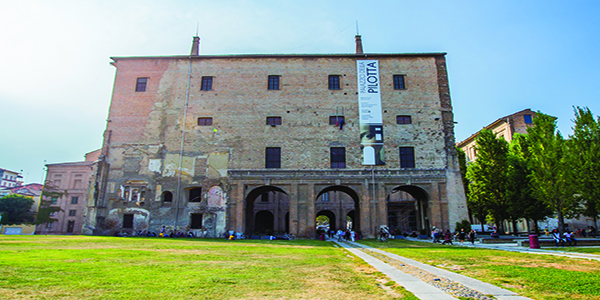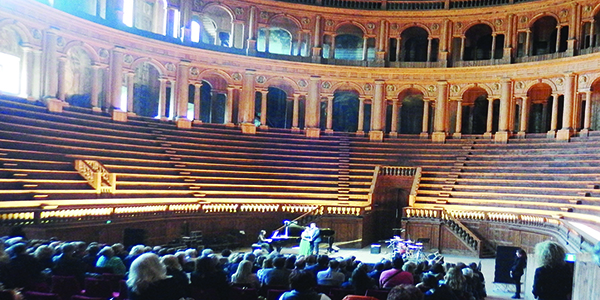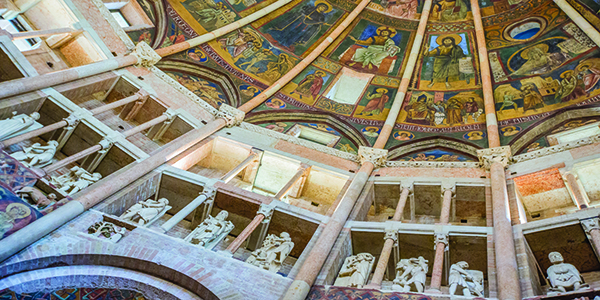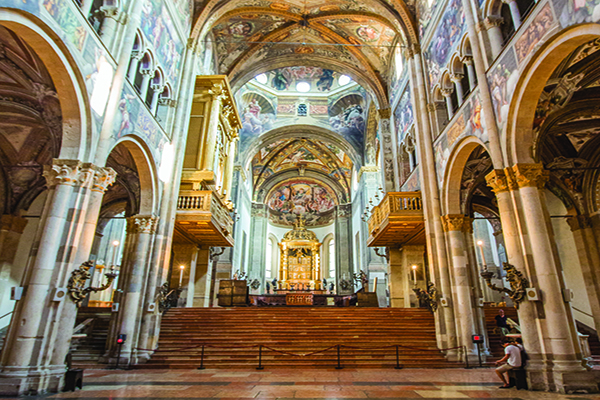Sara Scarpa spends a weekend in Parma, a city famous the world over for its ham and cheese, but one that also has much more to offer visitors.
We are all, of course, already very familiar with Parma: you must have had Parma ham, Parmesan cheese – and perhaps even a glass of the local Lambrusco before. These famous examples are just a few of the fantastic products that come from this area, and there is much more to the city and its environs than just food and wine, too. Located in Emilia-Romagna, the north-central region that lies in the Po River valley, Parma offers not only excellent gastronomy but also fascinating art, music and culture.
Just think of Verdi and Toscanini, Parmigianino and Correggio… What could be better than admiring the whirls of Correggio’s frescoes while listening to Verdi and enjoying a torta fritta with some Parma ham?

Unfortunately, you cannot do all this simultaneously, but you will not be far from it as all these wonderful things are not far from each other in the small centre of this city.
The centre is mainly for pedestrians and you can easily walk throughout the city, or cycle if you prefer. Emilia-Romagna is at the top of the list of Italian regions with the highest number of cyclists in relation to the number of inhabitants.
It is also the region that produced to the first mechanical kit that, applied to any bike, adds serious speed to it and turns it into an electric vehicle. In 2014 the Spaggiari brothers from Reggio Emilia won the Edison Pulse prize for this invention.
Palazzo della Pilotta
A short walk, or an even shorter cycle ride, from the train station will bring you to the front of the majestic Palazzo della Pilotta. Named after the Basque game of pelota (ball) that was played in its courtyards in centuries past, the palace was built in the second half of the 16th century at the order of Ranuccio I, Duke of Parma and Piacenza, to host the court services for the Farnese, the famous family who shaped the history of the area for almost two centuries.
The building is vast and unfinished and, as I stood outside on the grass bank, the Piazzale della Pace, just in front of it, I could not tell if it was a museum or just an enormous abandoned building. Had it not been for the big sign on its façade I would have questioned if I was indeed in the correct place. However, inside is a totally different story – it hosts the Farnese Theatre, three important museums (the National Gallery, the Archaeological Museum and the Bodoni Museum) and the Palatina Library.
Ranuccio I, the Duke who commissioned it, is finally getting some recognition. Even though he did not manage to be the greatest Duke of the Farnese family – that was left to his heroic father, Alessandro Farnese, who constantly overshadowed him by distinguishing himself in his career in arms – it was while Ranuccio was Duke that Parma and Piacenza flourished. This political message is well conveyed by the two well-known bronze equestrians statues of father and son (the work of Mochi) that dominate the old municipal town hall square in Piacenza, a town 35 miles southeast of Parma.

Ranuccio I, the ‘prince of peace’, not only commissioned the Palazzo Pilotta but also managed to guide a cultural revival in Parma, supporting arts and commissioning other important monuments and improvements which positively changed and enhanced the city. His actions allowed Parma to compete with the other European capitals and, at the same time, put him in the same power league as the infamous condottiere.
Your visit will start from the large salone on the first floor of the palace, which was originally intended as an armoury and was later turned into a theatre. The Teatro Farnese is a magical place and one of the few remaining examples in Italy of a permanent theatre with a mobile stage.
It was designed by the famous architect Giovan Battista Aleotti and built in 1618 by order, once again, of Ranuccio I to celebrate the passing of Cosimo II de’ Medici through Parma and therefore confirm the relationship between the families of the Farnese and Medici. The fragile theatre did not have a lucky history – Cosimo never turned up in Parma due to health problems, the theatre was only inaugurated 10 years later and it was only used on nine occasions thereafter.

After the last show it was then left to fall into ruin. However, on the few occasions it was used it must have looked spectacular with all the stuccoes and statues and with the spectacular naval battles here performed – the cavea of the theatre was then actually flooded via pumps hidden underneath the stage.
During World War II the theatre was almost destroyed when it was bombed but thankfully it was rebuilt and reopened in 1962.
The National Gallery has one of the best art collections in Italy and is definitely worth a visit.
Located on the second floor of the Pilotta Palace, the gallery was started by the Dukes of Parma, Don Philip and Don Ferdinand of Bourbon, and enriched by the acquisitions made by Marie Louise of Austria, Napoleon’s second wife. It contains pieces of art from the 13th century to the 19th century, including works by Correggio, Parmigianino, Tintoretto, Carracci, Tiepolo, Canaletto and Leonardo da Vinci.
The art of Correggio
Not far from Palazzo della Pilotta you can admire the small and enchanting Camera della Badessa with the domed ceiling which was decorated by Correggio at the beginning of the 16th century. The frescoes were commissioned by the Abbess Giovanna da Piacenza in the dining room of the former convent of St Paul and are considered one of the greatest masterpieces in Renaissance art.
If you had not heard of Correggio before do not worry: you will get to know him quite well in Parma as the place is dotted with his art. In the Duomo di Parma, only a few minutes away from the Palazzo della Pilotta, you will find the Assumption of the Virgin, one of the best examples of his art. Titian admired Correggio’s frescoes of the dome so much that he supposedly said that even if they had filled the whole dome with golden coins they still would have not paid the artist enough for what he had created – quite a compliment! Quite true indeed.

I was standing in the cathedral looking up for some time admiring its stunning dome as I was trying to distinguish the figures represented and, I must confess, I struggled, even with the help of my guide. However, I found it fascinating – all those bodies tangled up forming a whirl, a dramatic perspective di sotto in su (from below to above) which emphasises the reality of Heaven.
It is interesting to notice that the hundreds of foreshortened limbs amongst wispy clouds are clearer when you walk towards the choir. It is only from this area reserved for the clergy that it is possible to see the figure of Christ, almost to emphasise – as also happens in the church of San Giovanni Evangelista – the different points of view of the faithful and the clergy.
The Piazza Duomo
There is so much art concentrated in this square: the Bishop’s Palace, the Duomo and the Baptistery cover centuries of art. The Romanesque Duomo and the tower stand near the late Romanic-Gothic Baptistery. This latter is probably one of the most memorable buildings in Parma, and in the whole of Italy, and one of the best examples of the transition from Romanic to Gothic art.
Made of pink Verona marble, with the big portals, tiers of open loggias and a zoophorous (the panels with real and imaginary animals) winding all around its base, the Baptistery stands out from the outside.

Once inside you will really be astonished by the beauty of its vault – 16 segments beautifully decorated with frescoes extend radially from the keystone and create an enchanting umbrella vault.
Nothing in here is casual; all the architectural elements have a hidden symbolism and the recurring number eight is a symbol of the resurrection of Christ.
Gastronomic heartland
Not only does Parma offer architectural and artistic treasures but is also perfectly located should you wish to explore the ‘Food Valley’.
The city also boasts the qualification of UNESCO Creative City of Gastronomy.
The area around Parma offers a wide range of high quality produce renowned all over the world, such as Parmigiano Reggiano, Prosciutto di Parma, Culatello di Zibello and Spalla Cotta di San Secondo, Lambrusco and Fortara just to name a few. You could start your tour from Fontanellato, where you can admire Parmigianino’s stunning frescoes in the Rocca Sanvitale – if you find yourself there on the first Sunday of the month you can also browse at the antiques market which takes place in the main square.
From here you could drive to the historical village of San Secondo Parmense with the Rocca dei Rossi where you can enjoy some Spalla Cotta di San Secondo with a glass of Fortana di Taro (a wine also produced in the area) which Verdi loved so much.
Then visit Soragna, 28km north of Parma, with the beautiful Rocca Meli Lupi, a 14th-century fortress, and the Parmigiano Reggiano Museum. If you only have a weekend head to Zibello and get some Culatello di Zibello DOP, the king of salumi, and wash it down with a glass of Malvasia or Fortana!
